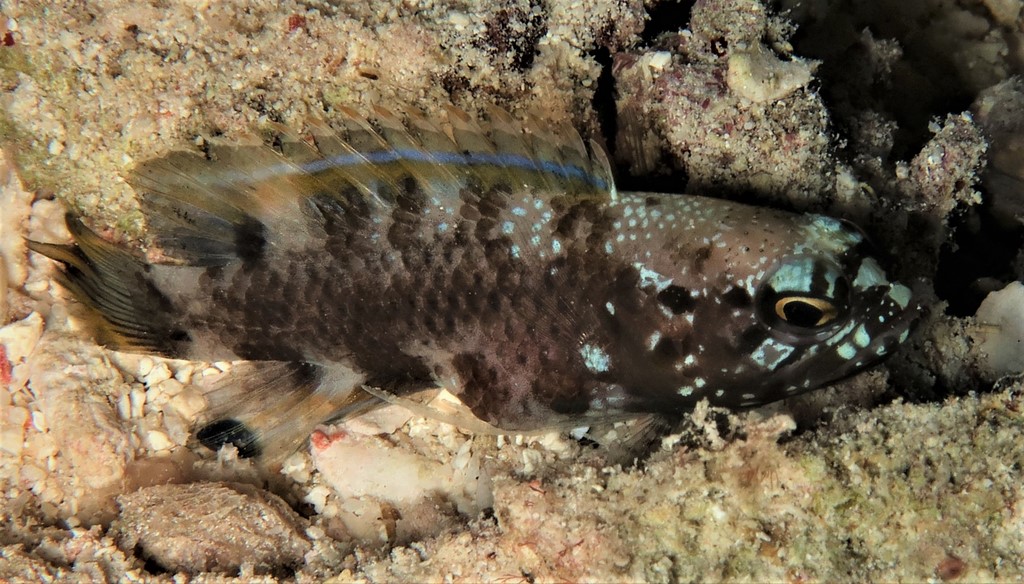PLESIOPS COERULEOLINEATUS - (RUPPELL, 1835)
icture courtesy of: Alain Daoulas
Actinopterygii (Gigaclass) > Actinopteri (Class) > Teleostei (Subclass) > Blenniiformes (Order) > Plesiopidae (Family) > Plesiopinae (Subfamily) > Plesiops (Genus)Banded devilfish, Coral devil, Coral longfin, Crimsontip longfin, Red-tipped longfin, Red-tipped prettyfin, Rooipunt-langvin, Tanabata-uo, タナバタウオ, 육돈바리, 蓝线鮗, 黑七夕魚,
Synonymes
Pharopteryx melas (Bleeker, 1849)
Pharopteryx semeion (Tanaka, 1917)
Plesiops caeruleolineatus (Rüppell, 1835)
Plesiops melas (Bleeker, 1849)
Plesiops nigricans apoda (Kner, 1868)
Plesiops semeion (Tanaka, 1917)
Plesiops welas (Bleeker, 1849)
Pseudochromichthys riukianus (Schmidt, 1931)
--------------------------
Description
Dorsal spines (total): 10-12; Dorsal soft rays (total): 6-8; Anal spines: 3; Anal soft rays: 8; Pectoral fin rays: 19-24; Pelvic fin rays: I, 4; Lateral line pores: 18-21 + 7-14; Gill rakers: 3-6 + 6-11. Body elongate, maxilla naked; Preopercular margin smooth; Teeth absent from tongue. Lateral line disjunct - dorsal lateral line running from upper end of opercle to last dorsal-fin ray, lower running midlaterally onto caudal peduncle. Membranes between dorsal-fin spines deeply incised; Pelvic fins elongate. Max. length: 10.0 cm. Depth range: 0 - 23 m.
Color
A dark brownish longfin with a blue-edged black stripe on the dorsal fin, red tips on the dorsal-fin spines, a dark blue line below the eye, and a pair of dark spots behind the eye. Juvenile are paler brown with whitish spots on the head.
Etymology
Plesiops: from Greek, plesios = close, near + from Ancient Greek, óps = eye, face, appearance. Referring to close-set eyes of unnamed species (possibly P. nigricans).
coeruleolineatus: from Latin, coerulus = azure-blue + from Latin, lineatu = lined. Reffering to the blue lines present in the dorsal and anal fins.
original description: Plesiops coeruleolineatus Rüppell, 1835 - Type locality: Massawa, Eritrea, Red Sea.
Distribution
Red Sea; Indo-West Pacific: East Africa (Mozambique, Tanzania, Kenya), Socotra (Yemen), Seychelles, Aldabra (Seychelles), Comoros, Madagascar, Saint Brandon's Shoals (Cargados Carajos) and Mascarenes (La Réunion, Mauritius, Rodrigues) east to Marshall Islands, Samoa and Tonga, north to southern Korea and southern Japan, south to Western Australia, Queensland (Australia) and New Caledonia.
Biology
Adults are found under stone or corals in flood basins and lagoons. They are common but very secretive and usually found when turning rubble pieces in pools. They venture out in the open at night to feed on small crustaceans, fishes and gastropods. Eggs are guarded by the male parent.
Last update: 17, March 2023
